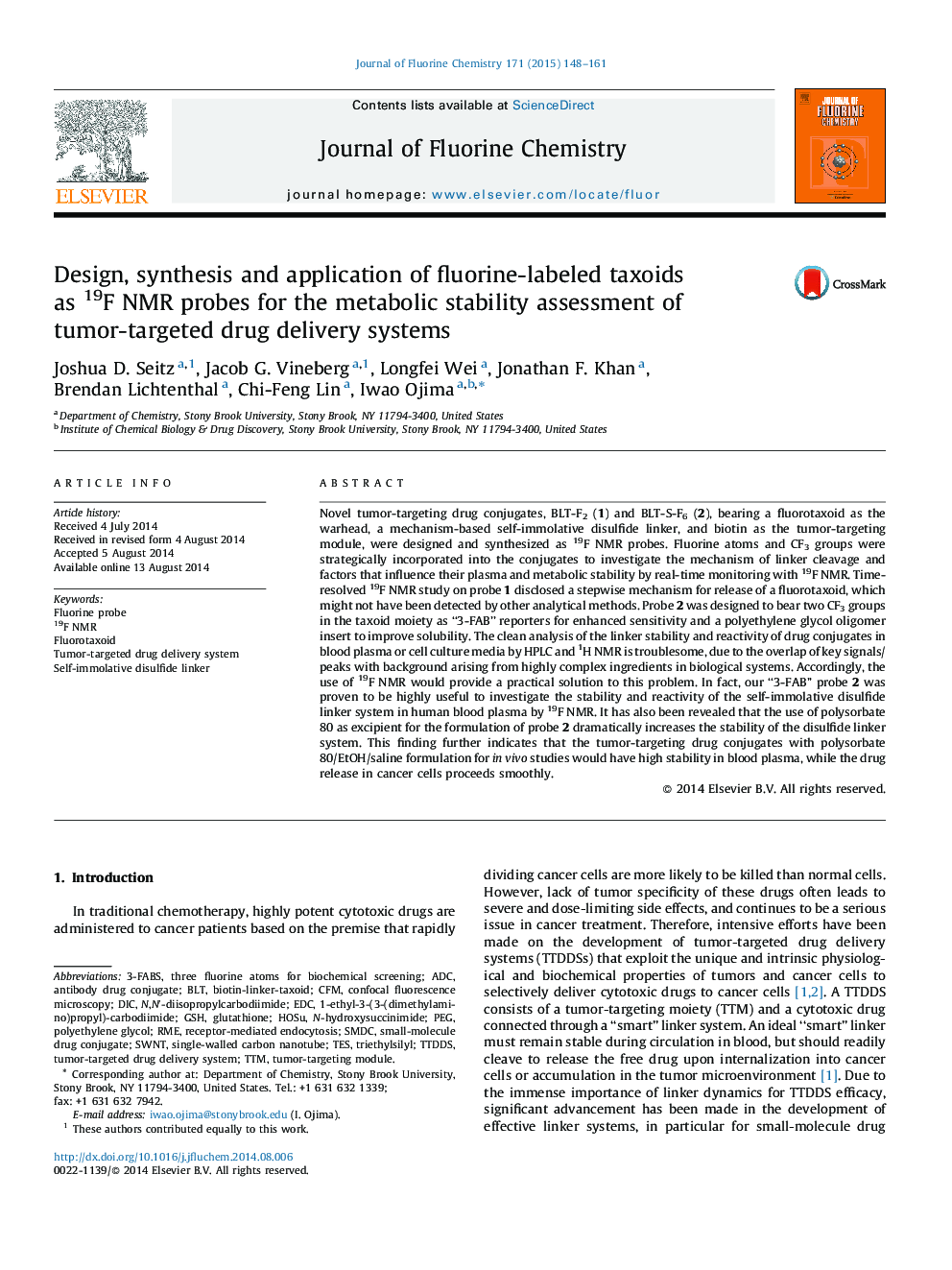| کد مقاله | کد نشریه | سال انتشار | مقاله انگلیسی | نسخه تمام متن |
|---|---|---|---|---|
| 1313615 | 1499329 | 2015 | 14 صفحه PDF | دانلود رایگان |

• Two novel tumor-targeting biotin conjugates, BLT-F2 (1) and BLT-S-F6 (2) were designed as 19F NMR probes.
• Rapid disulfide exchange of BLT-F2 (2) with GSH, followed by slow thiolactonization and drug release.
• para-Fluoro group accelerates rate of disulfide cleavage, but slows down thiolactonization.
• Linker cleavage was slowed with an excipient, indicating a strong “stabilizing effect.”
• BLT-S-F6 (2) is stable in blood plasma, yet releases the drug when exposed to cytosolic levels of GSH.
Novel tumor-targeting drug conjugates, BLT-F2 (1) and BLT-S-F6 (2), bearing a fluorotaxoid as the warhead, a mechanism-based self-immolative disulfide linker, and biotin as the tumor-targeting module, were designed and synthesized as 19F NMR probes. Fluorine atoms and CF3 groups were strategically incorporated into the conjugates to investigate the mechanism of linker cleavage and factors that influence their plasma and metabolic stability by real-time monitoring with 19F NMR. Time-resolved 19F NMR study on probe 1 disclosed a stepwise mechanism for release of a fluorotaxoid, which might not have been detected by other analytical methods. Probe 2 was designed to bear two CF3 groups in the taxoid moiety as “3-FAB” reporters for enhanced sensitivity and a polyethylene glycol oligomer insert to improve solubility. The clean analysis of the linker stability and reactivity of drug conjugates in blood plasma or cell culture media by HPLC and 1H NMR is troublesome, due to the overlap of key signals/peaks with background arising from highly complex ingredients in biological systems. Accordingly, the use of 19F NMR would provide a practical solution to this problem. In fact, our “3-FAB” probe 2 was proven to be highly useful to investigate the stability and reactivity of the self-immolative disulfide linker system in human blood plasma by 19F NMR. It has also been revealed that the use of polysorbate 80 as excipient for the formulation of probe 2 dramatically increases the stability of the disulfide linker system. This finding further indicates that the tumor-targeting drug conjugates with polysorbate 80/EtOH/saline formulation for in vivo studies would have high stability in blood plasma, while the drug release in cancer cells proceeds smoothly.
Novel biotin-linker-taxoid conjugates, BLT-F2 and BLT-S-F6, were synthesized with strategically incorporated fluorine substituents to observe disulfide linker cleavage by 19F NMR. Ring substitution of fluorine on the linker and formulation with excipients significantly altered the rates of disulfide exchange and thiolactonization. BLT-S-F6, with improved solubility and heightened sensitivity, demonstrated strong stability in blood plasma, but readily cleaved and released the taxoid when exposed to glutathione levels found in the cytosol.Figure optionsDownload as PowerPoint slide
Journal: Journal of Fluorine Chemistry - Volume 171, March 2015, Pages 148–161